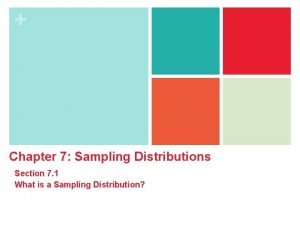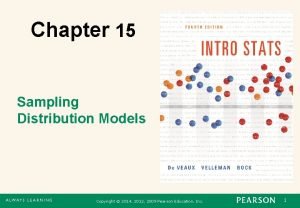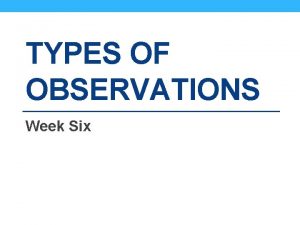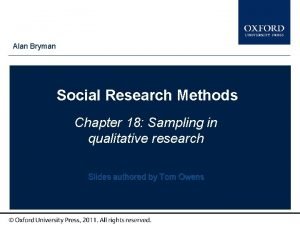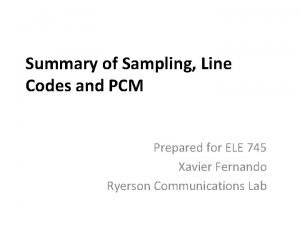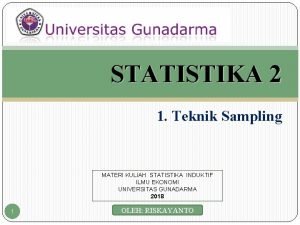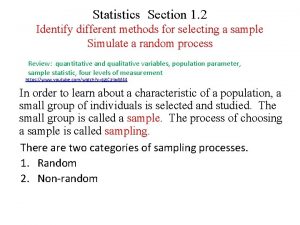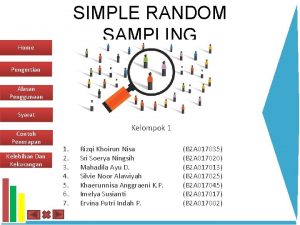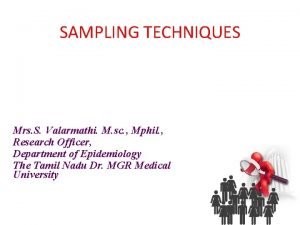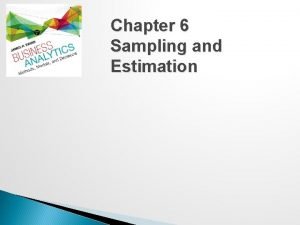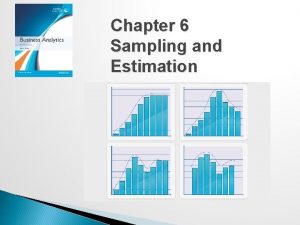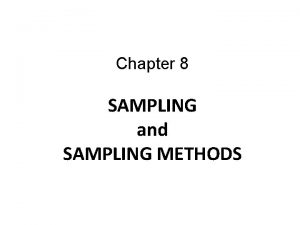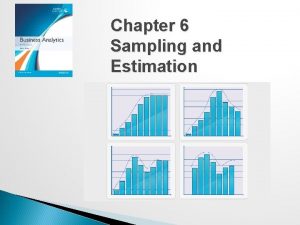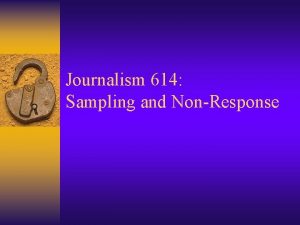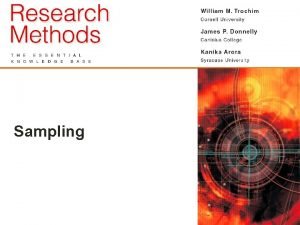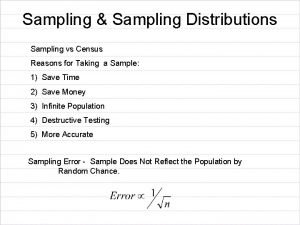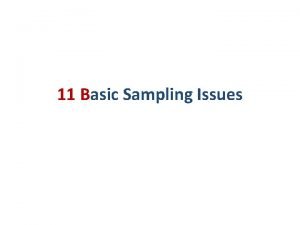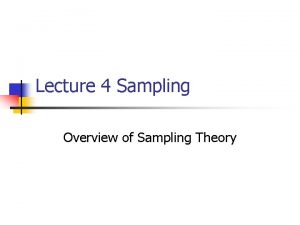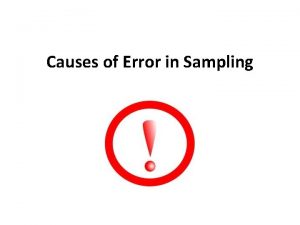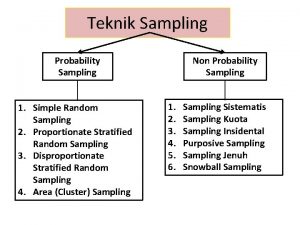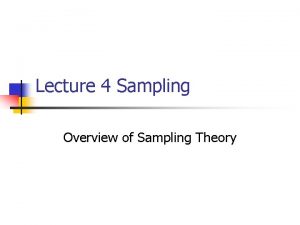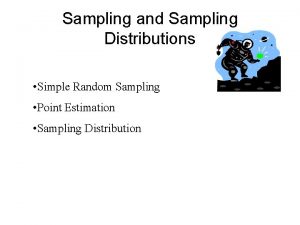Chapter 5 Sampling Sampling n n n Sampling

































- Slides: 33

Chapter 5 Sampling

Sampling n n n Sampling theory focuses on the generalizability of descriptive findings to the population from which the sample was drawn. It also considers whether statements can be generalized from one population to another. Sampling is unnecessary when the elements that would be sampled are identical, but the complexity of the social world makes it difficult to argue very often that different elements are identical.

Key Terms n n Population The entire set of individuals or other entities to which study findings are to be generalized. Sample- subset of a larger population used to study the population as a whole Elements The individual members of the population Sampling frame A list of all elements or other units containing the elements in a population.

n Researchers may use samples within samples when using groups as the units of analysis

Exhibit 5. 1

Generalizability n There are two different meanings of generalizability: ¡ ¡ Can the findings from a sample of the population be generalized to the population from which the sample was selected? Can the findings from a study of one population be generalized to another, somewhat different population?

Generalizability, cont. n n Sample generalizability depends on sample quality, which is determined by the amount of sampling error—the difference between the characteristics of a sample and the characteristics of the population from which it was selected. The larger the sampling error, the less representative the sample—and thus the less generalizable the findings.

Generalizability, cont. n To assess sample quality when you are planning or evaluating a study, ask yourself these questions: n From what population were the cases selected? What method was used to select cases from this population? Do the cases that were studied represent, in the aggregate, the population from which they were selected? n n n But researchers often project their theories onto groups or populations much larger than, or simply different from, those they have actually studied.

Generalizability, cont. n n n If a small sample has been studied in an experiment or field research project, the study should be replicated in different settings or, preferably, with a representative sample of the population to which generalizations are sought. i. e. medical trials of medications Representative sample A sample that “looks like” the population from which it was selected in all respects that are potentially relevant to the study.

Exhibit 5. 2

Generalizability, cont. n n n The distribution of characteristics among the elements of a representative sample is the same as the distribution of those characteristics among the total population. In an unrepresentative sample, some characteristics are overrepresented or underrepresented. Generalizability is not easy to achieve in Experiment – use random assignment instead

Generalizability, cont. n n n In some circumstances, it may be feasible to skirt the issue of generalizability by conducting a census —studying the entire population of interest—rather than drawing a sample. This is what the federal government tries to do every 10 years with the U. S. Census. The reason that social scientists don’t often attempt to collect data from all the members of some large population is simply that doing so would be too expensive and time-consuming—and they can do almost as well with a sample.

Sampling Methods n The most important distinction that needs to be made about samples is whether they are based on a probability or a nonprobability sampling method.

Sampling Methods, cont. n n n Probability sampling methods rely on a random, or chance, selection procedure, which is, in principle, the same as flipping a coin to decide which of two people “wins” and which one “loses. ” Heads and tails are equally likely to turn up in a coin toss, so both persons have an equal chance of winning. That chance, their probability of selection, is 1 out of 2, or. 5.

Sampling Methods, cont. n n n There is a natural tendency to confuse the concept of random sampling, in which cases are selected only on the basis of chance, with a haphazard method of sampling. But to ensure that nothing but chance influences the selection of cases, the researcher must proceed very methodically, leaving nothing to chance except the selection of the cases themselves. The researcher must follow carefully controlled procedures if a purely random process is to occur.

Probability Sampling Methods, cont. n n n The larger the sample, the more confidence we can have in the sample’s representativeness. The more homogenous the population, the more confidence we can have in the representativeness of a sample of any particular size. The fraction of the total population that a sample contains does not affect the sample’s representativeness unless that fraction is large.

Probability Sampling Methods, cont. n n Different types of random samples vary in their ability to minimize random error. The most common methods for drawing random samples are: Simple random sampling requires some procedure that generates numbers or otherwise identifies cases strictly on the basis of chance. Random digit dialing uses a machine that dials random numbers within the phone prefixes corresponding to the area in which the survey is to be conducted.

Probability Sampling Methods, cont. n n n In replacement sampling, each element is returned to the sampling frame after it is selected so that it may be sampled again. Systematic random sampling is a variant of simple random sampling. Arrange population elements sequentially, randomly select a starting point, select every nth subject. If need 5 subjects and have 45, select every 9 th person Stratified random sampling uses information known about the total population prior to sampling to make the sampling process more efficient. Select sample with mirror proportions on age, gender, religion etc.

Probability Sampling Methods, cont. n n n By using proportionate stratified sampling, each stratum would be represented exactly in proportion to its size in the population from which the sample was drawn. Cluster sampling – unit chosen is not an individual, but is a cluster of individuals naturally grouped together such as churches, schools, blocks, counties, businesses They are alike with respect to characteristics relevant to the study

Nonprobability Sampling Methods n n Nonprobability sampling methods are often used in qualitative research; they also are used in quantitative studies when researchers are unable to use probability selection methods. The use of nonprobability sampling methods in quantitative research too often reflects a lack of concern with generalizability or a lack of understanding of the importance of probability-based sampling.

Nonprobability Sampling Methods, cont. n n n Four common nonprobability sampling methods: Availability Sampling. Elements are selected for availability sampling because they’re available or easy to find. Thus, this sampling method is also known as a haphazard, accidental, or convenience sample. Psychological research often uses accidental or availability sampling - Ask doctor to ask patients to be part of study

Nonprobability Sampling Methods, cont. n n Snowball Sampling. Snowball sampling is useful for hard-to-reach or hard-to-identify populations for which there is no sampling frame, but the members of which are somewhat interconnected (at least some members of the population know each other). In non-probability sampling participants are not chosen by chance but are chosen due to economical and convenience reasons. Often used with hard to study groups.

Lessons About Sample Quality n n We can’t evaluate the quality of a sample if we don’t know what population it is supposed to represent. If the population is unspecified because the researchers were never clear about the population they were trying to sample, then we can safely conclude that the sample itself is no good. We can’t evaluate the quality of a sample if we don’t know how cases in the sample were selected from the population. If the method was specified, we then need to know whether cases were selected in a systematic fashion and on the basis of chance. In any case, we know that a haphazard method of sampling (as in person -on-the-street interviews) undermine generalizability.

Lessons About Sample Quality, cont. n We need to be aware that even researchers who obtain very good samples may talk about the implications of their findings for some group that is larger than, or just different from, the population they actually sampled. For example, findings from a representative sample of students in one university often are discussed as if they tell us about university students in general. And maybe they do; we just don’t know for sure.

Generalizability in Qualitative Research n Qualitative research often focuses on populations that are hard-to-locate or very limited in size. In consequence, such nonprobability sampling methods as availability sampling and snowball are often used.

Sampling Distributions, cont. n n Random sampling error may not result in an unrepresentative sample. The magnitude of sampling error due to chance factors can be estimated statistically. In a normal distribution, a predictable proportion of cases fall within certain ranges. Inferential statistics takes advantage of this feature and allows researchers to estimate how likely it is that, given a particular sample, the true population value will be within some range of the statistics.

Determining Sample Size n n The less sampling error desired, the larger the sample size must be. Samples of more homogeneous populations can be smaller than samples of more diverse populations. Stratified sampling uses prior information on the population to create more homogeneous population strata from which the sample can be selected, so stratified samples can be smaller than simple random samples.

Determining Sample Size, cont. n If the only analysis planned for a survey sample is to describe the population in terms of a few variables, a smaller sample is required than if a more complex analysis involving sample subgroups is planned.

Determining Sample Size, cont. n n n You can obtain some general guidance about sample sizes from the current practices of social scientists. For professional studies of the national population in which only a simple description is desired, professional social science studies typically have used a sample size of between 1, 000 and 1, 500 people, with up to 2, 500 being included if detailed analyses are planned. Studies of local or regional populations often sample only a few hundred people, in part because these studies lack sufficient funding to draw larger samples. Of course, the sampling error in these smaller studies is considerably larger than in a typical national study (Sudman 1976: 87).

Conclusions n n n Sampling is a powerful tool for social science research. Probability sampling methods allow a researcher to use the laws of chance, or probability, to draw samples from which population parameters can be estimated with a high degree of confidence. A sample of just 1, 000 or 1, 500 individuals can be used to estimate reliably the characteristics of the population of a nation comprising millions of individuals.

Conclusions, cont. n n But researchers do not come by representative samples easily. Well-designed samples require careful planning, some advance knowledge about the population to be sampled, and adherence to systematic selection procedures—all so that the selection procedures are not biased. And even after the sample data are collected, the researcher’s ability to generalize from the sample findings to the population is not completely certain. The best that he or she can do is to perform additional calculations that state the degree of confidence that can be placed in the sample statistic.

Conclusions, cont. n n n The alternatives to random, or probability-based, sampling methods are almost always much less palatable for quantitative studies, even though they typically are much cheaper. Without a method of selecting cases likely to represent the population in which the researcher is interested, research findings will have to be carefully qualified. Qualitative researchers whose goal is to understand a small group or setting in depth may necessarily have to use unrepresentative samples, but they must keep in mind that the generalizability of their findings will not be known.

Conclusions, cont. n n Social scientists often seek to generalize their conclusions from the population that they studied to some larger target population. The validity of generalizations of this type is necessarily uncertain, because having a representative sample of a particular population does not at all ensure that we find will hold true in other populations.
 Probability sampling vs non probability sampling
Probability sampling vs non probability sampling Cluster sampling advantages and disadvantages
Cluster sampling advantages and disadvantages Cluster random sampling
Cluster random sampling Contoh tabel event sampling
Contoh tabel event sampling Stratified sample vs cluster sample
Stratified sample vs cluster sample Non probability sampling
Non probability sampling Natural sampling vs flat top sampling
Natural sampling vs flat top sampling Chapter 7 sampling distributions
Chapter 7 sampling distributions Chapter 17 sampling distribution models
Chapter 17 sampling distribution models Ap stats chapter 17 sampling distribution models
Ap stats chapter 17 sampling distribution models Ap stats chapter 17 sampling distribution models
Ap stats chapter 17 sampling distribution models Derajat ketelitian adalah
Derajat ketelitian adalah Wso work sampling
Wso work sampling Variable sampling adalah
Variable sampling adalah Latin hypercube sampling excel
Latin hypercube sampling excel Sample of anecdotal records of students
Sample of anecdotal records of students Generic purposive sampling
Generic purposive sampling Dependent samples
Dependent samples Acceptance sampling procedure
Acceptance sampling procedure Non probability sampling self selection
Non probability sampling self selection Texture synthesis by non-parametric sampling
Texture synthesis by non-parametric sampling Probability sampling adalah
Probability sampling adalah Cluster sampling adalah
Cluster sampling adalah Signal mapping
Signal mapping Stimulus sampling theory
Stimulus sampling theory Developing a sampling plan
Developing a sampling plan Judgmental sampling adalah
Judgmental sampling adalah Cluster sample example
Cluster sample example Quadrat sampling example
Quadrat sampling example Kelebihan dan kekurangan simple random sampling
Kelebihan dan kekurangan simple random sampling Periodic sampling example
Periodic sampling example Consecutive sampling
Consecutive sampling Work sampling technique
Work sampling technique Representative population
Representative population







